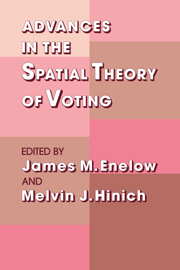Book contents
- Frontmatter
- Contents
- Foreword
- ADVANCES IN THE SPATIAL THEORY OF VOTING
- 1 Introduction
- 2 Multiparty Competition, Entry, and Entry Deterrence in Spatial Models of Elections
- 3 Heresthetic and Rhetoric in the Spatial Model
- 4 Spatial Strategies When Candidates Have Policy Preferences
- 5 A Decade of Experimental Research on Spatial Models of Elections and Committees
- 6 Candidate Uncertainty and Electoral Equilibria
- 7 The Theory of Predictive Mappings
- 8 Multicandidate Spatial Competition
- 9 The Setter Model
- Author Index
- Subject Index
3 - Heresthetic and Rhetoric in the Spatial Model
Published online by Cambridge University Press: 05 March 2012
- Frontmatter
- Contents
- Foreword
- ADVANCES IN THE SPATIAL THEORY OF VOTING
- 1 Introduction
- 2 Multiparty Competition, Entry, and Entry Deterrence in Spatial Models of Elections
- 3 Heresthetic and Rhetoric in the Spatial Model
- 4 Spatial Strategies When Candidates Have Policy Preferences
- 5 A Decade of Experimental Research on Spatial Models of Elections and Committees
- 6 Candidate Uncertainty and Electoral Equilibria
- 7 The Theory of Predictive Mappings
- 8 Multicandidate Spatial Competition
- 9 The Setter Model
- Author Index
- Subject Index
Summary
What are the moving parts in the spatial model of politics?
The formal theorems about equilibrium reveal nothing about moving parts. Black's median voter theorem simply identifies the equilibrium, given single-peaked utility curves, as the ideal point of the median voter (Black 1948, 1958). Plott's multidimensional extension of this theorem identifies the equilibrium, given convex utility curves, as the ideal point of the voter at the multidimensional median (Plott 1967). These fundamental facts require no moving parts, mainly because they describe outcomes from the black box, not the processes that go on inside it.
But if one wishes to get inside the black box to describe how the process moves toward equilibrium (or not, as the case may be), then it is necessary to assume something about the moving parts. In Downs's informal model of spatial competition, the candidates or parties position and reposition themselves, converging to the ideal of the median voter (Downs 1957). In McKelvey's agenda theorem, the agenda-controller moves motions in a trajectory toward his or her goal (McKelvey 1976, 1979). Something similar, but less well directed, occurs in Kramer's model of convergence to the minmax set (Kramer 1977). In the recent modifications of McKelvey's model (Ferejohn, McKelvey, and Packel 1984), as also in the models of Feld and Grofman (1988), the trajectories are confined to a central portion of the space, but still it is the motions that vary, not the voters.
- Type
- Chapter
- Information
- Advances in the Spatial Theory of Voting , pp. 46 - 65Publisher: Cambridge University PressPrint publication year: 1990
- 71
- Cited by

